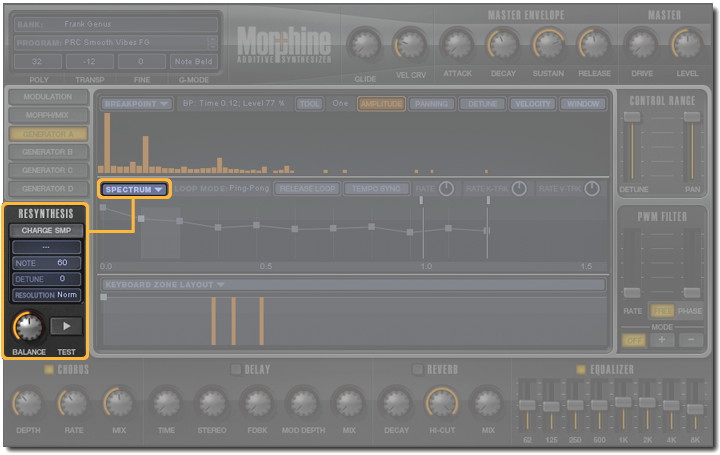INSTRUMENTS / GENERATORS
Morphine Resynthesis Panel

Resynthesis
The Resynthesis function takes an input sample and recreates the sound as a 'Spectrum' that is a series of Breakpoints. Each Breakpoint represents a harmonic 'snapshot' of the sound at a given moment in time. For the most accurate results Morphine offers several manual controls to 'tune' the resynthesized sound to the original. The tutorial at the bottom of this page has more details on manual tuning.
Controls
- CHARGE SMP - Charge Sample opens a Load Dialog to browse and load (Charge) samples. Clicking the button again when a sample is loaded will 'Uncharge' the sample, clearing it. Favor samples without effects and in the MIDI note range C4 to C5 for the best results.
- NOTE - Change the root note of the resynthesized sound (the note that corresponds to the original pitch of the sound). This is similar to the 'Root Note' function in a Sampler and is the main control to adjust when matching the resynthesized sound with the original sample.
- DETUNE - Fine tune. Changes the tuning of the resynthesized sound in cents.
- RESOLUTION - Changes the rate at which Breakpoints are laid down (similar to sample rate). The Normal setting is the lowest resolution while Best has the highest and works in conjunction with the SPECTRUM menu item 'Import charged sample'. Changes to RESOLUTION will only be audible once the resynthesized sound has been loaded to a ZONE (see below).
- BALANCE - Adjust the TEST playback balance between the original sample (fully left) and the resynthesized sound (fully right). The default is a 50/50 mix of the original and resynthesized sounds and is a good starting position as you use the Note & Detune controls to fine-tune the tone of the resynthesized sound to match the original.
- TEST - Starts/Stops a looped play-back of the original and resynthesized 'preview' sound. NOTE: The resynthesized sound heard here is a preview only (in order to reduce CPU load for testing). Always 'Import charged sample' (described below) to hear the final resynthesized sound.
- SPECTRUM (Menu) - Use the menu item 'Import charged sample' to load the spectrum into the currently selected Zone. Remember this will overwrite any existing data in the Zone.
Resynthesis Tutorial
The most accurate resynthesis will usually require your input, nothing can beat the human ear when matching sounds. A good analogy to keep in mind when Resynthesizing is: 'Load, Aim and Fire'. That is, 'Load' the sample, 'Aim' by adjusting the Resynthesis controls and 'Fire' by sending the sample to the desired Keyboard Zone. Details are as follows -
- Reset the patch: Start with a blank patch, Left-click in the Program Name field (top-left window in Morphine) and select 'Reset Program' to call a blank patch.
- 'Load': Load the sample to be resynthesized by clicking the CHARGE SMP button. Pad/String sounds are a good example to start with as they are usually the easiest to resynthesize. TIPS: Use 'dry' samples around C4 or C5. Reverb or delay effects are difficult for the resynthesis algorithm to interpret and often sound strange. The note range C4-C5 also tends to work best for single sounds stretched across the keyboard. If you intend to have multiple Keyboard Zones use a sample that is in the middle of the Keyboard Zone range that it will serve (the same principle that is applied to multi-sample patches on samplers).
- Play the sample: Pressing the TEST button will play the original sample and resynthesized sounds together to aid the 'tuning' procedure.
- Compare sounds: Use the BALANCE control to fade between the original (left-turn) and resynthesized (right-turn) sounds for comparison.
- 'Aim' by fine-tuning the sound: Adjust, first the NOTE and then DETUNE controls so that the original and resynthesized sounds are closely matched (if that is your goal). A good technique is to fade the BALANCE knob fully left/right after making adjustments, if you have the perfect resynthesis the sound won't change (much) as the BALANCE knob is moved. NOTES: 1. The resynthesized sound is only a preview, always 'Import charged sample' (described below) to hear the final resynthesized sound. 2. Untuned noises are difficult to resynthesize. For example the human voice, plosives, breath and similar untuned percussive sounds tend to acquire a 'vocoded' quality. To help resolve these issues the Noise Generator can be used to restore untuned noises to the patch. Note that you can load your own custom Noise Samples to the library if needed.
- 'Fire', shoot the resynthesized sound to a Zone: Open the SPECTRUM menu and import the Spectra into the selected Zone (Import charged sample). If desired you can
change the import resolution by selecting the RESOLUTION (Normal, High, Best) options in combination with the 'Import charged sample' step. If you have resynthesized a sample and the sound
is still out of tune (and you have set the Resynthesis DETUNE range to the max) the following method may help:
- 6.1 If you don't need to preserve Detune settings on other Spectra, turn down the 'Control Range' Detune slider (on the main interface) to the minimum setting. OR if you need to preserve Detune on other Spectra...
- 6.2 Select 1 breakpoint from inside the Spectrum window.
- 6.3 In the breakpoint window, select the 'Detune' view.
- 6.4 In the breakpoint menu, first select 'Copy Breakpoint', then select 'Paste current view to all breakpoints'. This will match the detuning levels of all Breakpoints to the current Detune selected, but won't alter the Amplitudes or Panning values.
This is particularly useful for sounds that are rich in higher harmonics (i.e.plucked sounds, hammered sounds, square-waves, etc).
It's that easy, Load, Aim and Fire!